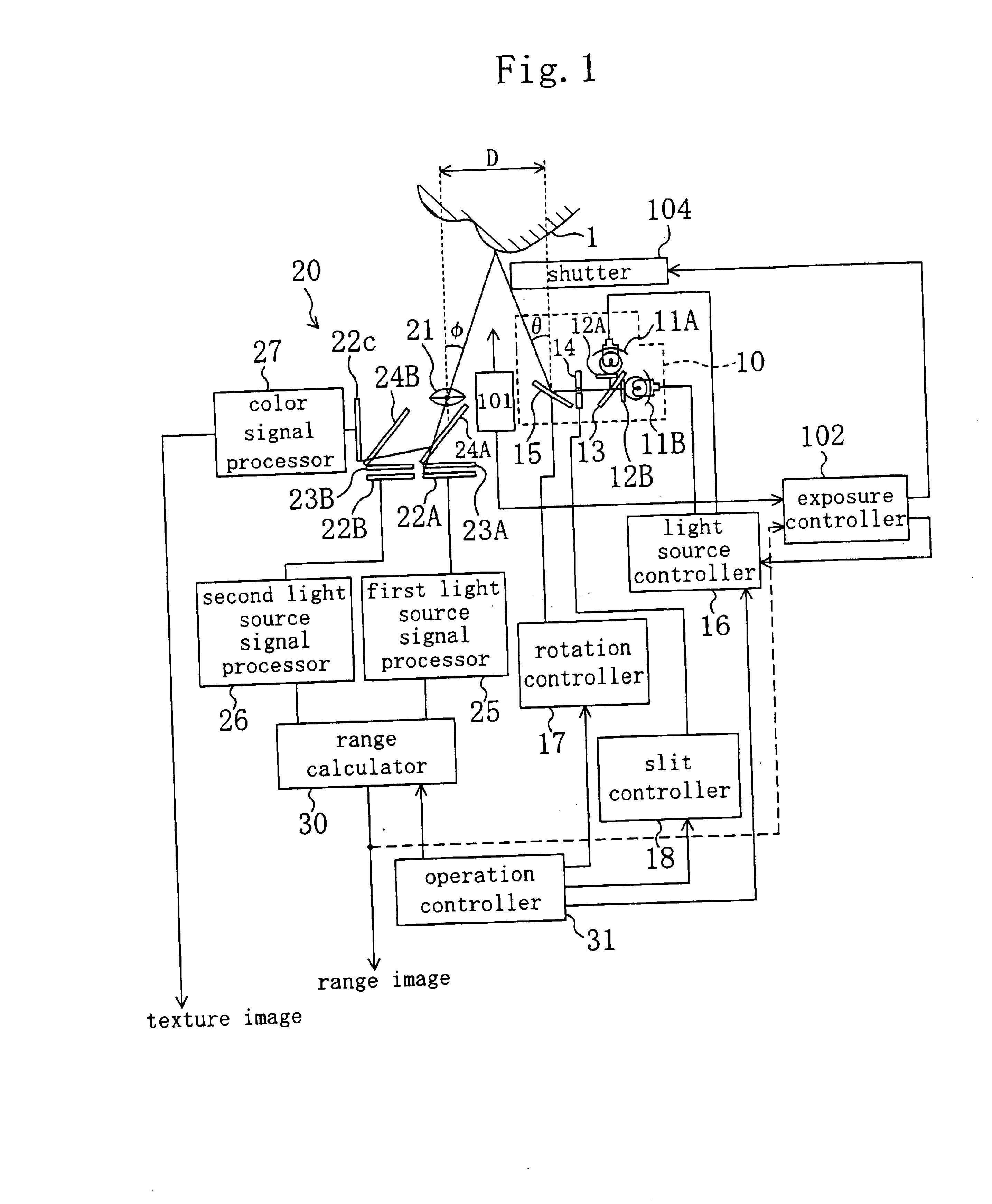Rangefinder for obtaining information from a three-dimensional object
a three-dimensional object and rangefinder technology, applied in the field of rangefinders, can solve the problems of user inability to obtain precise range information, taking too much time and trouble, and inability to effectively control the optical output power, and achieve the effect of high-precision information
- Summary
- Abstract
- Description
- Claims
- Application Information
AI Technical Summary
Benefits of technology
Problems solved by technology
Method used
Image
Examples
embodiment 1
FIG. 1 illustrates a configuration for a rangefinder according to a first exemplary embodiment of the present invention. In FIG. 1, the same members as those included in the prior art rangefinder shown in FIG. 22 are identified by the same reference numerals and the detailed description thereof will be omitted herein.
As shown in FIG. 1, the rangefinder includes a distance-measuring sensor 101 for estimating an approximate averaged distance from the rangefinder to an object 1. The distance-measuring sensor 101 is implementable as a sensor of the type detecting ultrasonic waves reflected from the object 1. The rangefinder also includes an exposure controller 102, which is equivalent to the controller as defined in the appended claims. Based on range information provided from the distance-measuring sensor 101, the exposure controller 102 controls the operations of a light source controller 16 and a shutter 104. As in the known rangefinder, the light source controller 16 controls the op...
embodiment 2
FIG. 5 illustrates a configuration for a rangefinder according to a second embodiment of the present invention. In FIG. 5, the same members as those included in the prior art rangefinder shown in FIG. 22 are identified by the same reference numerals and the detailed description thereof will be omitted herein. In the rangefinder shown in FIG. 5, light is also projected from a light source section 10 and part of the light that has been reflected from an object 1 is also received at a camera section 310, thereby obtaining information about the 3D location of the object 1. According to the second embodiment, the camera section 310 can capture a color image (i.e., a 2D image), too. The 3D location information is obtained by the known technique.
The camera section 310 includes a lens 312, a diaphragm 313, an imager (CCD) 314 and a neutral density (ND) filter 311, which is disposed in front of the lens 312. The ND filter 311 includes a liquid crystal device. The transmittance of the ND filt...
embodiment 3
FIG. 11 illustrates a configuration for a videophone system including an imager according to a third exemplary embodiment of the present invention. In FIG. 11, the same members as those included in the rangefinder shown in FIG. 5 are identified by the same reference numerals and the detailed description thereof will be omitted herein. In this case, an object 711 is a human face.
FIG. 12(a) illustrates how the imager shown in FIG. 11 performs time-sharing processing. As shown in FIG. 12(a), first and second intervals T1 and T2 alternate according to this embodiment. In the first interval T1, an infrared flash lamp 701a is lit and the image captured is divided into foreground and background parts based on the reflected part of the light. In the second interval T2, a color image (i.e., a 2D image) is captured and only the foreground part is separated from the image.
As shown in FIG. 11, a light source section 701 includes the infrared flash lamp 701a and a transmission liquid crystal dis...
PUM
 Login to View More
Login to View More Abstract
Description
Claims
Application Information
 Login to View More
Login to View More - R&D
- Intellectual Property
- Life Sciences
- Materials
- Tech Scout
- Unparalleled Data Quality
- Higher Quality Content
- 60% Fewer Hallucinations
Browse by: Latest US Patents, China's latest patents, Technical Efficacy Thesaurus, Application Domain, Technology Topic, Popular Technical Reports.
© 2025 PatSnap. All rights reserved.Legal|Privacy policy|Modern Slavery Act Transparency Statement|Sitemap|About US| Contact US: help@patsnap.com



